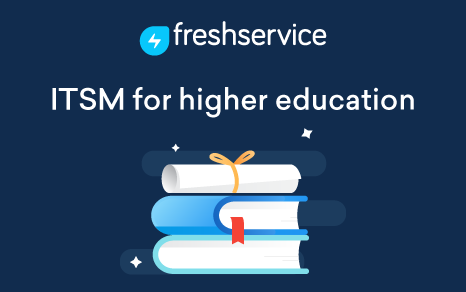Checklist for Implementing ITSM in educational institutions
According to the National Center for Educational Studies (NCES), approximately 2.9 million students graduate in a year from all educational institutes in the USA. This includes undergraduates and postgraduates. The scale of stakeholders also increases multi-fold with the 1.54 million teaching professionals (statistics from Bureau of Labor Statistics) that are part of the education sector. Every University or educational institution in its entirety can be viewed as an enterprise by the sheer scale of operations. Due to this large scale, challenges faced by university departments also increase proportionately.
-
Create a project transition plan
-
Self service awareness for all
-
Build an IT community
-
Integrate your service desk with student apps
-
Go Mobile
Create a project transition plan
When you kickstart an IT Service management program in your university, it is important to understand the IT mission and vision. ITSM is powered by implementing an effective service desk tool and therefore, create a project transition plan to replace your existing solution with a new service desk tool. Change management is crucial for smooth transition and to avoid downtime.
Self service awareness for all
Consolidate services provided by various departments and host them in a unified catalog that can be requested by students/faculty/alumni. Having a self-service portal to enable this would empower end users to identify the right service item and self-help themselves. Student self-service experience includes service catalog, FAQ access, submitting queries, checking for internal announcements etc.
Tips
Gamify your self-service portal to improve end user adoption. For example,
-
Have an auto response to emails to the service desk that says "We treat email tickets as low priority. Use self service portal for faster resolution", to improve self service adoption
-
Run prize draws for those who have raised a ticket through the Self Service portal for better adoption
Build an IT community
A University IT community fosters collaboration and engagement across all user groups. Communities include IT academy, research, CIO community, Training community etc. IT community results in innovation through collaboration. Examples include agile, ITIL, Devops and QA communities where experts come together to create internal initiatives and professional development programmes.
Integrate your service desk with student apps
Students use messenger apps like Slack for any internal communication. Therefore, integrate your service desk with student apps to drive adoption and easy accessibility. Marketing your service desk is an important activity to create awareness. It should be available within the student portal, internal websites and wherever easily accessible.
Go Mobile
Millennials are power users of smartphones. A service desk mobile app is a game changer in education with hands on functionalities and enables agents to resolve tickets on the move. This is especially helpful for the field services team which needs to report issues on the go and update statuses. Students also find mobile apps more handy in terms of checking alerts, timetable changes and library updates etc.
The Freshservice Advantage
According to the National Center for Educational Studies (NCES), approximately 2.9 million students graduate in a year from all educational institutes in the USA. This includes undergraduates and postgraduates. The scale of stakeholders also increases multi-fold with the 1.54 million teaching professionals (statistics from Bureau of Labor Statistics) that are part of the education sector. Every University or educational institution in its entirety can be viewed as an enterprise by the sheer scale of operations. Due to this large scale, challenges faced by university departments also increase proportionately.
-
Student on boarding
-
Data management services
-
Computers & software
Case study - Judson university
Judson University, is an evangelical Christian liberal arts university located in Elgin, Illinois, United States. It was founded in 1963. The university has campuses in Elgin and Rockford, Illinois, and a student body of approximately 1,300. Judson University has more than 60 undergraduate majors, minors, and pre-professional programs and is currently the only evangelical Christian college or university to over a fully accredited graduate program in architecture
|
KPI
|
PRE-FRESHSERVICE
|
WITH-FRESHSERVICE
|
|
First call resolution
|
20%
|
70%
|
|
Meeting SLAs
|
Not measured
|
90%
|
|
Customer Satisfaction
|
Not measured
|
92%
|
|
Managed changes
|
40%
|
100%
|
|
Serious change related incidents
|
26
|
2
|
|
Tickets raised via email
|
50%
|
33%
|
Intuitive user experience
Freshservice's modern and intuitive UI requires minimal or no training, and is customizable to IT and non-IT needs. With mobile capability, students and administration can have all this done through a single click on their mobile.
Increase adoption of IT system in your schools
The Service Catalog feature helps improve the campus experience as it facilitates students, faculty, and staff to easily and transparently access services through a shopping cart model. Service Catalog has approval and automation capabilities to accelerate service delivery
Intelligent automation
Freshservice automates ticket distribution, event and time based actions, asset discovery and repetitive tasks in the background, allowing crucial resources to focus on more mission critical tasks.
Pay what you want
Freshservice offers subscription plans that starts with a free 21-day trial period. There are no hidden costs, no support fees, and you only pay for the features you use. There is 24 X 7 email and 24 X s call support with every plan.
Empower your students and faculties to resolve issues
Self-service skips the trouble of bringing another person into the mix and empowers users to quickly find what they need and execute on a solution all on their own. The Knowledge Base is a repository of information for students, faculties, staff and admin. Through this portal admins can share, solution articles for IT issues and self-help, academic curriculum requirements, and governing policies.
Proven Implementation Methodology
The ease of transitioning and migrating to Freshservice is one of its USPs. Our personalized on boarding team follows a consultative solution approach and this is followed throughout the lifecycle of the customer.






